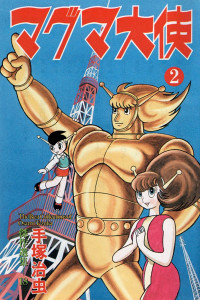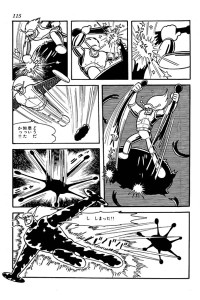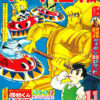Ambassador Magma (Manga)
Also known as マグマ大使 (Maguma Taishi)
| English Title: | Ambassador Magma |
| In English? | No |
| Japanese Title: | マグマ大使 Maguma Taishi |
| Type: | Ongoing Serial |
| Original run: | 1965/05 – 1967/08 |
| Published in: | Shonen Illustrated 少年画報 |
| Published by: | Shonen Gahosha |
| Volumes: | 3 MT-186 | MT-187 | MT-188 |
Originally serialized in Shonen Illustrated from May 1965 to August 1967, Ambassador Magma (1965-67) is Osamu Tezuka’s most recognizable entry in the long line of “giant robot” or mecha stories in Japanese manga adventures,
What it’s about
Mamoru, the son of newspaper journalist Atsushi Murakami, wakes up one morning to find that he and his family have traveled 200 million years back in time. Looking out their window they see dinosaurs walking around outside their house. The mysterious Goa appears before them and reveals that it was he who sent them back into the past in a show of his power. Proclaiming that he will soon take over the earth, Goa dares Murakami to report his plans in the paper.
When Mamoru returns to the present, he is visited by a giant robot named Magma who asks him for a photograph of the ancient world. He transforms himself into a rocket and brings Mamoru to a volcanic island where he meets Magma’s wife Mol and the man who created the world, the aptly-named “Earth”. Magma, along with his son Gam, who, strangely enough, looks almost exactly like Mamoru, have been created by Earth to defend the planet against threats from outer space – Goa being chief among them.
Magma then gives Mamoru a whistle he can use to call him and the other rocket-men whenever he is in trouble… which is handy because Goa‘s planetary invasion begins as transforming aliens known as “humanoids” begin to replacing key members of society in an attempt to subjugate the human race.
Oh, and if that’s not enough, Goa has the Devil Garon waiting in the wings…
What you should know
As even the most casual of manga fans know, “giant robots” (a.k.a. mecha) are a long established and one of the most popular genre of Japanese manga adventures. However, it is one of the few manga genres that Tezuka himself didn’t really popularize himself – an honour that is generally accredited to manga artist Mitsuteru Yokoyama and his series Iron Man No. 28 instead. Still, never one to shy away from a popular concept, Ambassador Magma (1965-67) is Tezuka’s most well-known entry into the genre … even though he does try to distinguish his living “rocket men” from their robotic cousins.
As with many of Tezuka’s manga works, at its core, Ambassador Magma (1965-67) is a story of transformation – illustrated primarily by Magma being able to transform into a rocket, Goa changing into a reptile, and, of course, the humanoids changing into everybody! The “shape-shifting alien” was a much used and well-loved part of Tezuka’s plot-device bag of tricks, and unsurprisingly the humanoids who appear in this story are analogous to the human clones found in his earlier series Zero Men (1959-60) and again, much later, in Neo-Faust (1988).
Of course the recycling of good ideas doesn’t stop there. Sharp-eyed readers may also notice that Koedamarine (an assassin sent by Goa) seems to be a prototype for Bolbok, the monstrous plant with a dark will, that later appears in The Three-Eyed One (1974-78). In fact, according to mangaka Kosei Ono, plants usually have a direct and crucial role to play in Tezuka’s stories about transformation (“Collected Manga Criticisms,” vol. 1, Heibonsha, 1989, pp. 67-103).
It is also interesting to note that Ambassador Magma (1965-67) seems to have benefited from the “before-glow” of Phoenix (1967-88) – a series which was just just ramping up as Ambassador Magma (1965-67) was coming to a close. Instead of just a straight-up sci-fi “super-robot” slugfest, Tezuka incorporates a significant amount of creation-mythology into the overall structure of the story. By having the being Chaos (the creator of the universe) refuse to simply side with Earth (the creator of the planet Earth) because he’s the “good guy”, we can see the early stage exploration of what constitutes good and evil within the greater context of the laws of the universe – a concept which Tezuka would of course explore much more fully in his masterpiece, Phoenix (1967-88).
Finally, fans may be interested to note that – arguably on the strength of the Magma/Garon battles alone – that a few years after the serialization of Ambassador Magma (1965-67) came to a close, Magma would go on to appear in the first color tokusatsu (i.e. “live action with special effects”) television series.
What else you should check out
Check out the link below for chapter summaries and more detailed original publication information on Ambassador Magma (1965-67) serialization in Shonen Illustrated.






